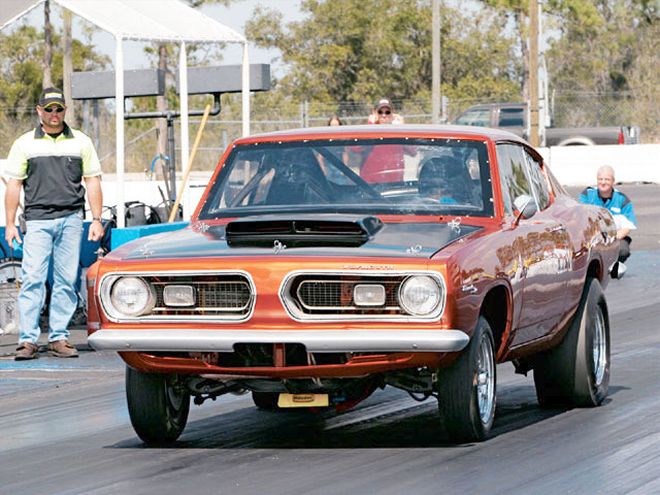

Whether building a performance car for the street or the strip, optimizing traction is always beneficial. While building a full-chassis race car or back-halving your car for giant tires is a great option to achieve optimal traction, the cost prohibits most of us from going to this extreme. Since this '67 Barracuda project is on a tight budget, we won't be altering the suspension of this car too far from the factory specifications. In fact, we won't even mini-tub it, so our biggest limitation to traction will be the tires we can fit into our factory wheelwells. We will, however, optimize traction by replacing worn items with quality components, upgrading the shocks and springs, and setting up the chassis using a few tricks we've learned over the years. Even though we're working on a dedicated racer, our techniques can be applied to your street car with similar results.
Going fast with huge rear tires is cool, but going fast with tires that fit into a stock wheel opening is even cooler. Plus, the expense of back-halving our project car would have eaten up a significant portion of our budget, so we decided to make the best of our Mopar's factory front and rear suspension.
Last month, we installed our Strange 60 rearend, along with Super Stock leaf springs and an aftermarket pinion snubber. This month, we'll install new Just Suspension front end bushings, mid-'70s A-Body front disc brakes, and Strange Engineering double-adjustable race shocks on all four corners. These modifications should get our A-Body launching straight and hard, and help us achieve our goal of sub-1.50-second 60-foot times.
Hooking up with small tires, even slicks, requires careful setup of the car's chassis. A-Body Mopars, especially when equipped with a big-block like ours, have notoriously poor weight distribution with most of the car's weight on the front end. To counteract this poor distribution of weight, the car must work well, lifting the front end and transferring weight to the rear tires for traction. This is a fine line to walk as too little weight transfer will induce tire spin, and too much may result in giant wheelies, which waste energy by lifting the car up instead of propelling it down the track. To achieve the weight transfer we'll need, we're running Strange Engineering double-adjustable race shocks on all four corners.
Up front, our Strange shocks will be adjusted for easy extension, allowing the car's front end to lift easily and transfer the weight of the car to its rear tires. These shocks will also allow us to adjust the rate of compression, keeping the weight transferred to the rear tires during first gear when torque multiplication makes it hardest to hook up. Also up front, we'll be using the factory V-8 torsion bars. We know the Slant Six bars have been the choice of drag racers since the early days, but with modern shock technology we've found it best to have a little stiffer torsion bar up front, making it easier to control the lift and compression of the front end.
Aside from the aforementioned upgrades, we'll rebuild the front suspension using a standard Just Suspension master kit. Regardless of your application, it's always a safe move to replace the worn suspension bushings in your Mopar. For drag racing, it's even more important as sloppy suspension can cause major chassis tuning and traction problems, not to mention the safety issue if something does break or come loose.
Speaking of safety, we're also upgrading our front brakes to late-model A-Body discs. This is an easy swap and will greatly decrease our car's stopping distance when compared to the original 9-inch drums. Once our chassis upgrades are complete, we'll put the car on our wheel scales for final adjustments before going to the track for final tuning.
Aside from a tie-rod separator and a press to install our new control arm bushings, rebuilding and upgrading our suspension was accomplished with basic hand tools and took us about a weekend of easy work. If your car's steering is sloppy, whether on the street or track, you'll definitely notice a difference by installing new bushings in your front end. If you're planning to race your Mopar, the techniques we'll show you here should shave some elapsed time from your timeslips.